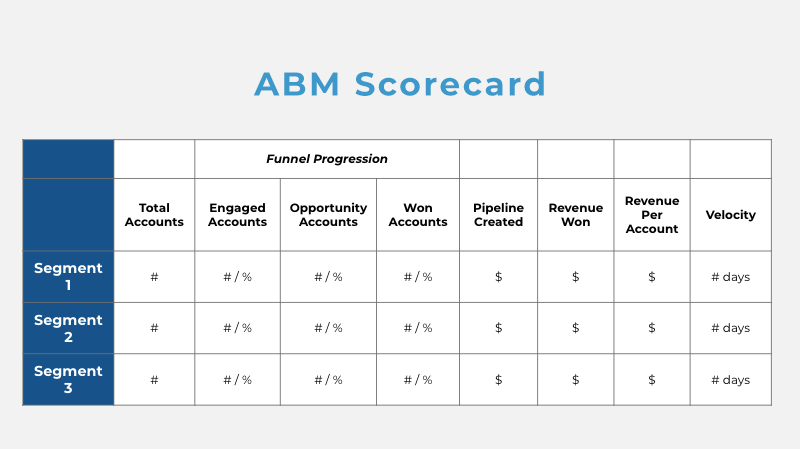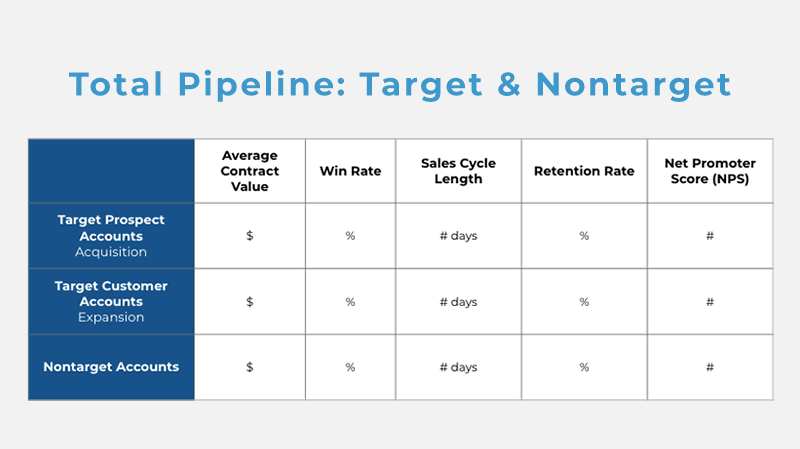All the ABM metrics to measure for your quarterly reporting
- Fahad H

- Dec 17, 2018
- 3 min read

You know the drill. The end of the quarter rolls around, so you dust off your go-to spreadsheets and dashboards. It’s once again time to distill three months’ worth of marketing into one quarterly report.
But this time, something is different. You’ve been working with your sales team on a list of target accounts, and your trusty old reporting model isn’t quite cutting it. It’s time to take an account-based approach to measurement.
Why account-based measurement is different
There are two big problems with using a traditional demand funnel to measure ABM.
The traditional funnel is designed to track leads, not to give you a holistic view of your accounts.
With traditional demand generation, you’re constantly pouring more leads into the top of your funnel. The top of the ABM funnel is static — accounts are not added throughout the quarter — because you’re working with a predefined target account list.
When organizations use a traditional funnel to measure ABM, they sometimes “wrongly conclude their [ABM] programs are ineffective and get a distorted view of their account-based strategy ROI,” says TOPO analyst Eric Wittlake in his new Account-Based Measurement Model report.
To put it simply: If you’re targeting accounts, you need to measure accounts.
Now, no one is suggesting you throw away your tried-and-true marketing reports. Instead, you need to operate a separate funnel for your target accounts.
What does this look like? Let’s look at the new funnel and all the account-based metrics you should be reporting to your organization.
Measuring the new account-based funnel
You know how I said you need a separate funnel for your ABM strategy? I lied.
You actually need two separate funnels.
If your key account strategy focuses on both acquiring new customers and getting more value out of existing ones (it should!) then you’ll need two unique target account lists that you measure separately. These lists will be the basis for your target account acquisition pipeline (prospects) and your target account expansion pipeline (current customers).

As outlined by TOPO, the key stages of the account-based funnel are:
Target accounts: Your strategic prospect or customer account list for the quarter.
Engaged target accounts: Target accounts that have shown meaningful engagement with your company and are ready for one-to-one outreach. This stage of the funnel, which can also be called marketing qualified accounts (MQAs), can serve as a proxy for the MQL stage of the lead-based funnel.
Opportunity target accounts: Target accounts that are in an active sales cycle.
Won target accounts: Target accounts with closed-won deals — the ultimate goal!
Of course, every company has a unique sales process. You may want to customize your ABM funnel by adding additional engagement and opportunity stages. The most important thing is that all your internal stakeholders understand your new ABM funnel.
Your account-based funnel KPIs will be the number of accounts in each of these stages, the conversion rates between stages, and the length of time between stages.
Your ABM scorecard
To report on your account-based funnel metrics, you’ll need an ABM scorecard — an at-a-glance look at how your different ABM programs are performing.
Here’s a sample ABM scorecard you can use to compare your results across different target account segments.

Account-based marketing technology can help you automate a report like this by pulling in account data from your CRM, marketing automation platform, and any other number of marketing tools. When you do this, you’ll have an always up-to-date source of truth that your entire organization can reference at any time. You can also build your scorecard manually — we did for a long time — but keep in mind that you’ll need to set aside time to update it on a regular basis.
Reporting on total pipeline: ABM, inbound, and outbound
Now, the big question: How does your target account strategy compare to the rest of your marketing strategy?
TOPO created a straightforward model for comparison, and we expanded on it below. You can use this simple report to demonstrate the impact your ABM programs are having on key business outcomes.

Total pipeline comparison metrics include:
Average contract value
Win rate
Sales cycle length
Retention rate
Net promoter score
Remember: ABM measurement involves a mind shift
Account-based marketing isn’t rocket science, but it’s new to a lot of teams — and change doesn’t happen overnight. It’s a whole lot easier to make an organizational shift when you can put your money where your mouth is. That’s why taking an account-based approach to measurement is absolutely critical to your target account strategy.
So go ahead and break out your usual lead-based dashboards, but it’s time to make some room on your shelf for a new type of reporting, too: ABM measurement.








Comments